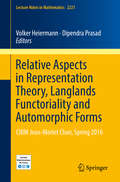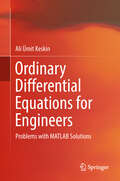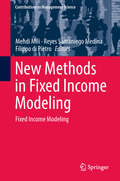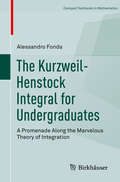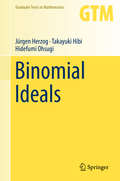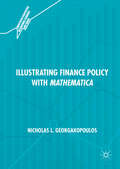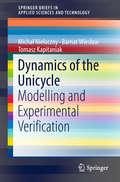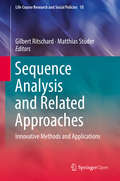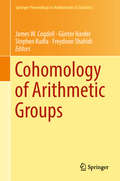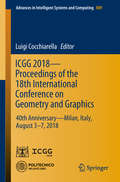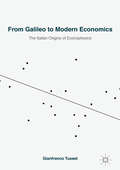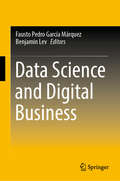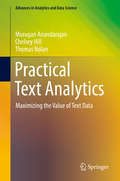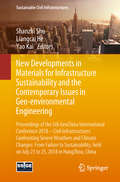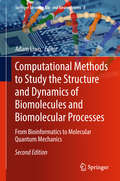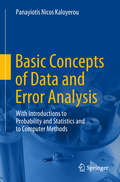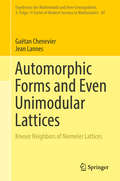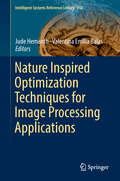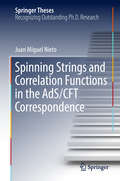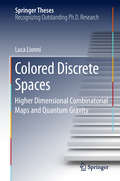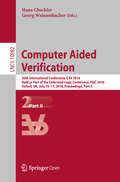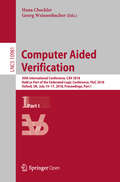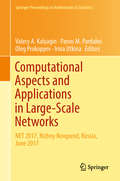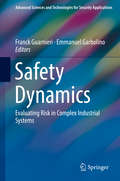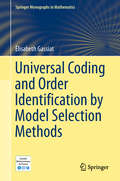- Table View
- List View
Relative Aspects in Representation Theory, Langlands Functoriality and Automorphic Forms: CIRM Jean-Morlet Chair, Spring 2016 (Lecture Notes in Mathematics #2221)
by Volker Heiermann Dipendra PrasadThis volume presents a panorama of the diverse activities organized by V. Heiermann and D. Prasad in Marseille at the CIRM for the Chaire Morlet event during the first semester of 2016. It assembles together expository articles on topics which previously could only be found in research papers. Starting with a very detailed article by P. Baumann and S. Riche on the geometric Satake correspondence, the book continues with three introductory articles on distinguished representations due to P. Broussous, F. Murnaghan, and O. Offen; an expository article of I. Badulescu on the Jacquet–Langlands correspondence; a paper of J. Arthur on functoriality and the trace formula in the context of "Beyond Endoscopy", taken from the Simons Proceedings; an article of W-W. Li attempting to generalize Godement–Jacquet theory; and a research paper of C. Moeglin and D. Renard, applying the trace formula to the local Langlands classification for classical groups. The book should be of interest to students as well as professional researchers working in the broad area of number theory and representation theory.
Ordinary Differential Equations for Engineers: Problems with MATLAB Solutions
by Ali Ümit KeskinThis monograph presents teaching material in the field of differential equations while addressing applications and topics in electrical and biomedical engineering primarily. The book contains problems with varying levels of difficulty, including Matlab simulations. The target audience comprises advanced undergraduate and graduate students as well as lecturers, but the book may also be beneficial for practicing engineers alike.
New Methods in Fixed Income Modeling: Fixed Income Modeling (Contributions to Management Science)
by Mehdi Mili Reyes Samaniego Medina Filippo Di PietroThis book presents new approaches to fixed income modeling and portfolio management techniques. Taking into account the latest mathematical and econometric developments in finance, it analyzes the hedging securities and structured instruments that are offered by banks, since recent research in the field of fixed incomes and financial markets has raised awareness for changes in market risk management strategies. The book offers a valuable resource for all researchers and practitioners interested in the theory behind fixed income instruments, and in their applications in financial portfolio management.
The Kurzweil-Henstock Integral for Undergraduates: A Promenade Along the Marvelous Theory of Integration (Compact Textbooks in Mathematics)
by Alessandro FondaThis beginners' course provides students with a general and sufficiently easy to grasp theory of the Kurzweil-Henstock integral. The integral is indeed more general than Lebesgue's in RN, but its construction is rather simple, since it makes use of Riemann sums which, being geometrically viewable, are more easy to be understood. The theory is developed also for functions of several variables, and for differential forms, as well, finally leading to the celebrated Stokes–Cartan formula. In the appendices, differential calculus in RN is reviewed, with the theory of differentiable manifolds. Also, the Banach–Tarski paradox is presented here, with a complete proof, a rather peculiar argument for this type of monographs.
Binomial Ideals (Graduate Texts in Mathematics #279)
by Takayuki Hibi Jürgen Herzog Hidefumi OhsugiThis textbook provides an introduction to the combinatorial and statistical aspects of commutative algebra with an emphasis on binomial ideals. In addition to thorough coverage of the basic concepts and theory, it explores current trends, results, and applications of binomial ideals to other areas of mathematics. The book begins with a brief, self-contained overview of the modern theory of Gröbner bases and the necessary algebraic and homological concepts from commutative algebra. Binomials and binomial ideals are then considered in detail, along with a short introduction to convex polytopes. Chapters in the remainder of the text can be read independently and explore specific aspects of the theory of binomial ideals, including edge rings and edge polytopes, join-meet ideals of finite lattices, binomial edge ideals, ideals generated by 2-minors, and binomial ideals arising from statistics. Each chapter concludes with a set of exercises and a list of related topics and results that will complement and offer a better understanding of the material presented.Binomial Ideals is suitable for graduate students in courses on commutative algebra, algebraic combinatorics, and statistics. Additionally, researchers interested in any of these areas but familiar with only the basic facts of commutative algebra will find it to be a valuable resource.
Illustrating Finance Policy with Mathematica (Quantitative Perspectives On Behavioral Economics And Finance Ser.)
by Nicholas L. GeorgakopoulosStudents in various disciplines—from law and government to business and health policy—need to understand several quantitative aspects of finance (such as the capital asset pricing model or financial options) and policy analysis (e.g., assessing the weight of probabilistic evidence) but often have little quantitative background. This book illustrates those phenomena and explains how to illustrate them using the powerful visuals that computing can produce. Of particular interest to graduate students and scholars in need of sharper quantitative methods, this book introduces the reader to Mathematica, enables readers to use Mathematica to produce their own illustrations, and places specific emphasis on finance and policy as well as the foundations of probability theory.
Dynamics of the Unicycle: Modelling And Experimental Verification (SpringerBriefs in Applied Sciences and Technology)
by Tomasz Kapitaniak Michał Niełaczny Barnat WiesławThis book presents a three-dimensional model of the complete unicycle–unicyclist system. A unicycle with a unicyclist on it represents a very complex system. It combines Mechanics, Biomechanics and Control Theory into the system, and is impressive in both its simplicity and improbability. Even more amazing is the fact that most unicyclists don’t know that what they’re doing is, according to science, impossible – just like bumblebees theoretically shouldn’t be able to fly. This book is devoted to the problem of modeling and controlling a 3D dynamical system consisting of a single-wheeled vehicle, namely a unicycle and the cyclist (unicyclist) riding it. The equations of motion are derived with the aid of the rarely used Boltzmann–Hamel Equations in Matrix Form, which are based on quasi-velocities. The Matrix Form allows Hamel coefficients to be automatically generated, and eliminates all the difficulties associated with determining these quantities. The equations of motion are solved by means of Wolfram Mathematica. To more faithfully represent the unicyclist as part of the model, the model is extended according to the main principles of biomechanics. The impact of the pneumatic tire is investigated using the Pacejka Magic Formula model including experimental determination of the stiffness coefficient. The aim of control is to maintain the unicycle–unicyclist system in an unstable equilibrium around a given angular position. The control system, based on LQ Regulator, is applied in Wolfram Mathematica. Lastly, experimental validation, 3D motion capture using software OptiTrack – Motive:Body and high-speed cameras are employed to test the model’s legitimacy. The description of the unicycle–unicyclist system dynamical model, simulation results, and experimental validation are all presented in detail.
Sequence Analysis and Related Approaches: Innovative Methods and Applications (Life Course Research and Social Policies #10)
by Gilbert Ritschard Matthias StuderThis open access book provides innovative methods and original applications of sequence analysis (SA) and related methods for analysing longitudinal data describing life trajectories such as professional careers, family paths, the succession of health statuses, or the time use. The applications as well as the methodological contributions proposed in this book pay special attention to the combined use of SA and other methods for longitudinal data such as event history analysis, Markov modelling, and sequence network. The methodological contributions in this book include among others original propositions for measuring the precarity of work trajectories, Markov-based methods for clustering sequences, fuzzy and monothetic clustering of sequences, network-based SA, joint use of SA and hidden Markov models, and of SA and survival models. The applications cover the comparison of gendered occupational trajectories in Germany, the study of the changes in women market participation in Denmark, the study of typical day of dual-earner couples in Italy, of mobility patterns in Togo, of internet addiction in Switzerland, and of the quality of employment career after a first unemployment spell. As such this book provides a wealth of information for social scientists interested in quantitative life course analysis, and all those working in sociology, demography, economics, health, psychology, social policy, and statistics.
Cohomology of Arithmetic Groups: On the Occasion of Joachim Schwermer's 66th Birthday, Bonn, Germany, June 2016 (Springer Proceedings in Mathematics & Statistics #245)
by James W. Cogdell Günter Harder Stephen Kudla Freydoon ShahidiThis book discusses the mathematical interests of Joachim Schwermer, who throughout his career has focused on the cohomology of arithmetic groups, automorphic forms and the geometry of arithmetic manifolds. To mark his 66th birthday, the editors brought together mathematical experts to offer an overview of the current state of research in these and related areas. The result is this book, with contributions ranging from topology to arithmetic. It probes the relation between cohomology of arithmetic groups and automorphic forms and their L-functions, and spans the range from classical Bianchi groups to the theory of Shimura varieties. It is a valuable reference for both experts in the fields and for graduate students and postdocs wanting to discover where the current frontiers lie.
ICGG 2018 - Proceedings of the 18th International Conference on Geometry and Graphics: 40th Anniversary - Milan, Italy, August 3-7, 2018 (Advances in Intelligent Systems and Computing #809)
by Luigi CocchiarellaThis book gathers peer-reviewed papers presented at the 18th International Conference on Geometry and Graphics (ICGG), held in Milan, Italy, on August 3-7, 2018. The spectrum of papers ranges from theoretical research to applications, including education, in several fields of science, technology and the arts. The ICGG 2018 mainly focused on the following topics and subtopics: Theoretical Graphics and Geometry (Geometry of Curves and Surfaces, Kinematic and Descriptive Geometry, Computer Aided Geometric Design), Applied Geometry and Graphics (Modeling of Objects, Phenomena and Processes, Applications of Geometry in Engineering, Art and Architecture, Computer Animation and Games, Graphic Simulation in Urban and Territorial Studies), Engineering Computer Graphics (Computer Aided Design and Drafting, Computational Geometry, Geometric and Solid Modeling, Image Synthesis, Pattern Recognition, Digital Image Processing) and Graphics Education (Education Technology Research, Multimedia Educational Software Development, E-learning, Virtual Reality, Educational Systems, Educational Software Development Tools, MOOCs). Given its breadth of coverage, the book introduces engineers, architects and designers interested in computer applications, graphics and geometry to the latest advances in the field, with a particular focus on science, the arts and mathematics education.
From Galileo to Modern Economics: The Italian Origins of Econophysics
by Gianfranco TussetEmpirical laws are rare in economics. This book describes efforts to anchor economic knowledge to invariant empirical laws. It links 17th and 18th century Galilean monetary economists to econophysics, a field that emerged in the mid-1990s. This virtual journey from past to present is charted by episodes on aggregates and empirical primacy. It includes the virtually unknown story of 19th century scholars who, by searching for a stricter mathematical approach, paved the way to an ‘engineering’ view of economics. Then there are celebrities like Pareto and his first empirical law governing the distribution of wealth. Pareto and Amoroso sparked a debate on the skewed distribution that spanned decades, ranging from finance to market transformations, to econophysics, with its concepts and tools inherited from statistical physics. The last stage of the journey goes through econophysics and the recent gradual advances it has made, which show how its position vis-à-vis economics has been changing.
Data Science and Digital Business
by Fausto Pedro García Márquez Benjamin LevThis book combines the analytic principles of digital business and data science with business practice and big data. The interdisciplinary, contributed volume provides an interface between the main disciplines of engineering and technology and business administration. Written for managers, engineers and researchers who want to understand big data and develop new skills that are necessary in the digital business, it not only discusses the latest research, but also presents case studies demonstrating the successful application of data in the digital business.
Practical Text Analytics: Maximizing the Value of Text Data (Advances in Analytics and Data Science #2)
by Murugan Anandarajan Chelsey Hill Thomas NolanThis book introduces text analytics as a valuable method for deriving insights from text data. Unlike other text analytics publications, Practical Text Analytics: Maximizing the Value of Text Data makes technical concepts accessible to those without extensive experience in the field. Using text analytics, organizations can derive insights from content such as emails, documents, and social media. Practical Text Analytics is divided into five parts. The first part introduces text analytics, discusses the relationship with content analysis, and provides a general overview of text mining methodology. In the second part, the authors discuss the practice of text analytics, including data preparation and the overall planning process. The third part covers text analytics techniques such as cluster analysis, topic models, and machine learning. In the fourth part of the book, readers learn about techniques used to communicate insights from text analysis, including data storytelling. The final part of Practical Text Analytics offers examples of the application of software programs for text analytics, enabling readers to mine their own text data to uncover information.
New Developments in Materials for Infrastructure Sustainability and the Contemporary Issues in Geo-environmental Engineering: Proceedings of the 5th GeoChina International Conference 2018 – Civil Infrastructures Confronting Severe Weathers and Climate Changes: From Failure to Sustainability, held on July 23 to 25, 2018 in HangZhou, China (Sustainable Civil Infrastructures)
by Shanzhi Shu Liangcai He Yao KaiThis book contains research papers focusing on recent advances throughout the world in theories and technologies of geotechnical engineering and the relevant disciplines. Topics includes: numerical modeling, earthquake engineering, geomaterial application in soil improvement and geo-environmental engineering, foundation engineering, and geo-environmental engineering.. Papers were selected from the 5th GeoChina International Conference 2018 – Civil Infrastructures Confronting Severe Weathers and Climate Changes: From Failure to Sustainability, held on July 23 to 25, 2018 in HangZhou, China.
Computational Methods to Study the Structure and Dynamics of Biomolecules and Biomolecular Processes: From Bioinformatics to Molecular Quantum Mechanics (Springer Series on Bio- and Neurosystems #8)
by Adam LiwoThis book provides a comprehensive overview of modern computer-based techniques for analyzing the structure, properties and dynamics of biomolecules and biomolecular processes. It is organized in four main parts; the first one deals with methodology of molecular simulations; the second one with applications of molecular simulations; the third one introduces bioinformatics methods and the use of experimental information in molecular simulations; the last part reports on selected applications of molecular quantum mechanics. This second edition has been thoroughly revised and updated to include the latest progresses made in the respective field of research.
Basic Concepts of Data and Error Analysis: With Introductions to Probability and Statistics and to Computer Methods
by Panayiotis Nicos KaloyerouThis introductory textbook explains the concepts and methods of data and error analysis needed for laboratory experiment write-ups, especially physics and engineering experiments. The book contains the material needed for beginning students, e.g., first year university students, college students (enrolled on a certificate or diploma course) and even A-level students. Nevertheless, it also covers the required material for higher year university laboratories, including the final year. Only essential concepts and methods needed for the day-to-day performance of experiments and their subsequent analysis and presentation are included and, at the same time, presented as simply as possible. Non-essential detail is avoided. Chapter five is a stand-alone introduction to probability and statistics aimed at providing a theoretical background to the data and error analysis chapters one to four. Computer methods are introduced in Chapter six. The author hopes this book will serve as a constant reference.
Automorphic Forms and Even Unimodular Lattices: Kneser Neighbors of Niemeier Lattices (Ergebnisse der Mathematik und ihrer Grenzgebiete. 3. Folge / A Series of Modern Surveys in Mathematics #69)
by Gaëtan Chenevier Jean LannesThis book includes a self-contained approach of the general theory of quadratic forms and integral Euclidean lattices, as well as a presentation of the theory of automorphic forms and Langlands' conjectures, ranging from the first definitions to the recent and deep classification results due to James Arthur.Its connecting thread is a question about lattices of rank 24: the problem of p-neighborhoods between Niemeier lattices. This question, whose expression is quite elementary, is in fact very natural from the automorphic point of view, and turns out to be surprisingly intriguing. We explain how the new advances in the Langlands program mentioned above pave the way for a solution. This study proves to be very rich, leading us to classical themes such as theta series, Siegel modular forms, the triality principle, L-functions and congruences between Galois representations.This monograph is intended for any mathematician with an interest in Euclidean lattices, automorphic forms or number theory. A large part of it is meant to be accessible to non-specialists.
Nature Inspired Optimization Techniques for Image Processing Applications (Intelligent Systems Reference Library #150)
by Valentina Emilia Balas Jude HemanthThis book provides a platform for exploring nature-inspired optimization techniques in the context of imaging applications. Optimization has become part and parcel of all computational vision applications, and since the amount of data used in these applications is vast, the need for optimization techniques has increased exponentially. These accuracy and complexity are a major area of concern when it comes to practical applications. However, these optimization techniques have not yet been fully explored in the context of imaging applications. By presenting interdisciplinary concepts, ranging from optimization to image processing, the book appeals to a broad readership, while also encouraging budding engineers to pursue and employ innovative nature-inspired techniques for image processing applications.
Spinning Strings and Correlation Functions in the AdS/CFT Correspondence (Springer Theses)
by Juan Miguel NietoThis book addresses several aspects of the integrable structure of the AdS/CFT correspondence. In particular it presents computations made on both sides of the AdS/CFT correspondence, at weak and at strong coupling. On the string theory side of the correspondence, the book focuses on the evaluation of the energy spectrum of closed string solutions moving in some deformed backgrounds that preserve integrability. On the gauge theory side, it explores various formal problems arising in the computation of two and three-point functions by means of the Algebraic Bethe Ansatz and the Quantum Inverse Scattering method. The book features numerous results on integrability in the context of the AdS/CFT correspondence. Self-contained and pedagogical, it includes general discussions and detailed presentations on the use of integrable systems techniques and their applications.
Colored Discrete Spaces: Higher Dimensional Combinatorial Maps and Quantum Gravity (Springer Theses)
by Luca LionniThis book provides a number of combinatorial tools that allow a systematic study of very general discrete spaces involved in the context of discrete quantum gravity. In any dimension D, we can discretize Euclidean gravity in the absence of matter over random discrete spaces obtained by gluing families of polytopes together in all possible ways. These spaces are then classified according to their curvature. In D=2, it results in a theory of random discrete spheres, which converge in the continuum limit towards the Brownian sphere, a random fractal space interpreted as a quantum random space-time. In this limit, the continuous Liouville theory of D=2 quantum gravity is recovered. Previous results in higher dimension regarded triangulations, converging towards a continuum random tree, or gluings of simple building blocks of small sizes, for which multi-trace matrix model results are recovered in any even dimension. In this book, the author develops a bijection with stacked two-dimensional discrete surfaces for the most general colored building blocks, and details how it can be used to classify colored discrete spaces according to their curvature. The way in which this combinatorial problem arrises in discrete quantum gravity and random tensor models is discussed in detail.
Computer Aided Verification: 30th International Conference, CAV 2018, Held as Part of the Federated Logic Conference, FloC 2018, Oxford, UK, July 14-17, 2018, Proceedings, Part II (Lecture Notes in Computer Science #10982)
by Hana Chockler Georg WeissenbacherThis open access two-volume set LNCS 10980 and 10981 constitutes the refereed proceedings of the 30th International Conference on Computer Aided Verification, CAV 2018, held in Oxford, UK, in July 2018. The 52 full and 13 tool papers presented together with 3 invited papers and 2 tutorials were carefully reviewed and selected from 215 submissions. The papers cover a wide range of topics and techniques, from algorithmic and logical foundations of verification to practical applications in distributed, networked, cyber-physical, and autonomous systems. They are organized in topical sections on model checking, program analysis using polyhedra, synthesis, learning, runtime verification, hybrid and timed systems, tools, probabilistic systems, static analysis, theory and security, SAT, SMT and decisions procedures, concurrency, and CPS, hardware, industrial applications.
Computer Aided Verification: 30th International Conference, CAV 2018, Held as Part of the Federated Logic Conference, FloC 2018, Oxford, UK, July 14-17, 2018, Proceedings, Part I (Lecture Notes in Computer Science #10981)
by Hana Chockler Georg WeissenbacherThis open access two-volume set LNCS 10980 and 10981 constitutes the refereed proceedings of the 30th International Conference on Computer Aided Verification, CAV 2018, held in Oxford, UK, in July 2018. The 52 full and 13 tool papers presented together with 3 invited papers and 2 tutorials were carefully reviewed and selected from 215 submissions. The papers cover a wide range of topics and techniques, from algorithmic and logical foundations of verification to practical applications in distributed, networked, cyber-physical, and autonomous systems. They are organized in topical sections on model checking, program analysis using polyhedra, synthesis, learning, runtime verification, hybrid and timed systems, tools, probabilistic systems, static analysis, theory and security, SAT, SMT and decisions procedures, concurrency, and CPS, hardware, industrial applications.
Computational Aspects and Applications in Large-Scale Networks: NET 2017, Nizhny Novgorod, Russia, June 2017 (Springer Proceedings in Mathematics & Statistics #247)
by Panos M. Pardalos Valery A. Kalyagin Oleg Prokopyev Irina UtkinaContributions in this volume focus on computationally efficient algorithms and rigorous mathematical theories for analyzing large-scale networks. Researchers and students in mathematics, economics, statistics, computer science and engineering will find this collection a valuable resource filled with the latest research in network analysis. Computational aspects and applications of large-scale networks in market models, neural networks, social networks, power transmission grids, maximum clique problem, telecommunication networks, and complexity graphs are included with new tools for efficient network analysis of large-scale networks. This proceeding is a result of the 7th International Conference in Network Analysis, held at the Higher School of Economics, Nizhny Novgorod in June 2017. The conference brought together scientists, engineers, and researchers from academia, industry, and government.
Safety Dynamics: Evaluating Risk in Complex Industrial Systems (Advanced Sciences and Technologies for Security Applications)
by Emmanuel Garbolino Franck GuarnieriThis book describes a systematic approach to risk assessment for complex socio-technical systems like industrial processes, especially innovative ones. It provides an overview of applications of system dynamics theory and methodologies on industrial systems in order to demonstrate the relevance of such an approach in helping to assess risks in such complex systems. An important feature of this approach is that it takes into account the dynamic of the interactions of the components (technical, human and organizational ones) in order to study and simulate the behavior of the system. This methodology helps to define the failures and/or accident scenarios and to implement and test the prevention and protection barriers. This book is of particular interest to students and teachers at university level (Master and Doctorate) and to engineers interested in risk analysis and management.
Universal Coding and Order Identification by Model Selection Methods (Springer Monographs in Mathematics)
by Élisabeth Gassiat Anna Ben-HamouThe purpose of these notes is to highlight the far-reaching connections between Information Theory and Statistics. Universal coding and adaptive compression are indeed closely related to statistical inference concerning processes and using maximum likelihood or Bayesian methods. The book is divided into four chapters, the first of which introduces readers to lossless coding, provides an intrinsic lower bound on the codeword length in terms of Shannon’s entropy, and presents some coding methods that can achieve this lower bound, provided the source distribution is known. In turn, Chapter 2 addresses universal coding on finite alphabets, and seeks to find coding procedures that can achieve the optimal compression rate, regardless of the source distribution. It also quantifies the speed of convergence of the compression rate to the source entropy rate. These powerful results do not extend to infinite alphabets. In Chapter 3, it is shown that there are no universal codes over the class of stationary ergodic sources over a countable alphabet. This negative result prompts at least two different approaches: the introduction of smaller sub-classes of sources known as envelope classes, over which adaptive coding may be feasible, and the redefinition of the performance criterion by focusing on compressing the message pattern. Finally, Chapter 4 deals with the question of order identification in statistics. This question belongs to the class of model selection problems and arises in various practical situations in which the goal is to identify an integer characterizing the model: the length of dependency for a Markov chain, number of hidden states for a hidden Markov chain, and number of populations for a population mixture. The coding ideas and techniques developed in previous chapters allow us to obtain new results in this area. This book is accessible to anyone with a graduate level in Mathematics, and will appeal to information theoreticians and mathematical statisticians alike. Except for Chapter 4, all proofs are detailed and all tools needed to understand the text are reviewed.
